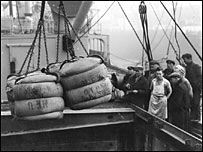I heard a siren from the dock
Saw a train set the night on fire
Smelled the spring on the sulfured wind
Dirty old town, whoa-oh, dirty old town
Ewan McColl Dirty Old Town
In the 1970s I was taken by my school to visit the docks at Manchester. We went on a boat which weaved between the ships that were scattered throughout the docks, which in those days were seen as an important part of the economy of the city, one which children should know about and value.
Many Manchester families had links with the docks, in my case my uncle worked there, taking his docker’s hook home at night. Like many dockers he was Irish , for the dock community included people from many ethnic backgrounds, including African. Billy Johnson, for instance, father of boxer and Communist Len Johnson, had worked there in the early 1900s as a pilot escorting the boats into the docks, having come from Sierra Leone.
Manchester and Salford docks were opened in 1894 by Queen Victoria. They were part of the newly completed Manchester Ship Canal, which meant that large ships could now navigate through the waterways to Ordsall.
Looking around Salford Quays to-day it is hard imagine how the docks once gave employment to thousands of people across Salford, Manchester and Trafford, from the era when dock work was casual and men lined up to be picked for a day’s work, to the heyday of the 1970s when the Transport and General Workers Union had negotiated good employment terms and conditions for its workers.
The docks were the third busiest port in Britain with merchant ships of 12,500 tons in weight bringing in a variety of goods to feed the local and national community. Thousands of people worked in the ports, not just dockers and labourers but the crews from the various liners and merchant ships that were constantly visiting the port as well as customs officials, office staff, canteen workers and cleaners.
In 1982, due to the increasing use of containers and an increased trade with the European Common Market, the docks were closed down. In the 1990s the docks became the Salford Quays. This represented the massive change in our economy: from a manufacturing one to a service based one.
Cleansed of a thriving dock community, the area to-day has almost a Stepford Wives aura. There are many flats, from which hardly anyone seems moves in or out of, sitting amongst the prestigious Lowry Theatre and Imperial War Museum. The only signs left of the past are the art deco dock office and two large cranes. The cranes were erected on south dock 6 (now known as Merchants Quay and Clippers Quay) in 1966, but were decommissioned in 1988 when they were moved to their present home.
They have taken on a new life as Alice Darlington, has run a one woman campaign to save them from demolition. She says:
It was a great industry, and these cranes are a landmark of that era. Once these cranes have been demolished it will be hard for young people to remember what the docks were all about and how important Salford was as a trading post. The cranes are enormous and represent how important the docks were to the economic health of the nation.
Cranes were an essential part of the docks, used to load and unloaded goods. There were over 200 at the height of the working life of the docks. The remaining two cranes are iconic and are a landmark in the area, made by Stothert and Pittand specifically designed with one single column leg for Dock 6.
Alice Darlington tried to get the cranes listed by English Heritage, due to their uniqueness, but they refused to do so, and this has been rubberstamped by the Secretary of State.
Darlington says she cannot understand a Labour Mayor Ian Stewart’s refusal to support the campaign to keep the cranes:
I don’t understand why a Labour representative is so against the working class heritage of Salford. If he keeps the cranes it could offer jobs to local people to maintain them.
As Salford Council make massive cuts to their frontline services they have responded to the campaign over the cranes by citing financial reasons. Labour Mayor Ian Stewart:
It would be wrong to spend £1million on preserving two rusting and dangerous cranes, when the people of Salford are struggling to make ends meet
Darlington and other local cranes campaigners, including the Salford Star, challenge the figures and believe that the money for refurbishment has been ringfenced and that they would only need to raise £22,500 from private sources to make up the shortfall from the Council.
The spotlight is now on Salford Council to see if they will demolish the cranes. Darlington is continuing with her e-petition and is gathering support from the local community as she takes her paper petitions around the local area.
We are getting lots of support from all parts of the community and the press. The cranes are part of a rich heritage for Salford people and it is important to remember that it was one of the greatest inland ports of the world.
Sign the petition at http://epetitions.direct.gov.uk/petitions/45202
If you have enjoyed this article and would like to support this blog by making a donation you can do using this button



